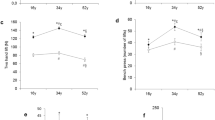Summary
A population of healthy middle-aged (n=69) and elderly men (n=12), who participated in a health promotion program, was studied to determine whether really physically fit individuals are in good biological condition, and also whether improvement of physical fitness in the middle-aged and the elderly reduces their “rate of aging”. Biological and physical fitness ages of the individuals studied were estimated from the data for 18 physiological function tests and 5 physical fitness tests, respectively, by a principal component model. The correlation coefficient between the estimated biological and physical fitness ages was 0.72 (p<0.01). Detailed analyses of the relationship between the estimated biological and physical fitness ages revealed that those who manifested a higher (“older”) physical fitness age did not necessarily have a higher biological age, but those who manifested a lower (“younger”) physical fitness age were also found to have a lower biological age. These results suggested that there were considerable individual variations in the relationship between biological condition and physical fitness among individuals with an old physical fitness age, but those who were in a state of high physical fitness maintained a relatively good biological condition. The data regarding the elderly men who had maintained a regular exercise program indicated that their estimated biologica ages were considerably younger than the expected values. This might suggest that in older individuals regular physical activity may provide physiological improvements which in turn might reduce “the rate of aging”.
Similar content being viewed by others
References
Anderberg MG (1973) Cluster analysis for applications. Academic Press, New York, pp 26–152
Andersen SF (1985) An historical overview of geriatric medicine: definition and aims. In: Pathy MSJ (ed) Principles and practice of geriatric medicine. Wiley, London, pp 7–13
Astrand PO (1956) Human physical fitness with special reference to sex and age. Physiol Rev 36:307–335
Bourliére F (1978) Ecology of human senescence. In: Brocklehurst JC (ed) Textbook of geriatric medicine and gerontology, 2nd edn. Churchill Livingstone, London, pp 71–85
Bruce RA (1984) Exercise, functional aerobic capacity, and aging — another viewpoint. Med Sci Sports Exerc 16:8–13
Comfort A (1969) Test-battery to measure ageing-rate in man. Lancet 27:1411–1415
deVries HA (1970) Physiological effects of an exercise training regimen upon men aged 52–88. J Gerontol 25:325–336
deVries HA (1971) Exercise intensity threshold for improvement of cardiovascular-respiratory function in older men. Geriatrics 26:94–101
Dubina TL, Dyudikova VA, Zhuk EV (1983) Biological age and its estimation. II. Assessment of biological age of albino rats by multiple regression analysis. Exp Gerontol 18:5–18
Dubina TL, Mints AYa, Zhuk EV (1984) Biological age and its estimation. II. Introduction of a correction to the multiple regression model of biological age and assessment of biological age in cross-sectional and longitudinal studies. Exp Gerontol 19:133–143
Edington DW, Cosmas AC, McCafferty WB (1972) Exercise and longevity: evidence for a threshold age. J Gerontol 27:341–343
Furukawa T, Inoue M, Kajiya F, Inada H, Takasugi S, Fukui S, Takeda H, Abe H (1975) Assessment of biological age by multiple regression analysis. J Gerontol 30:422–434
Goodrick CL (1980) Effects of long-term voluntary wheel exercise on male and female Wistar rats. 1. Longevity, body weight and metabolic rate. Gerontology 26:22–33
Harman HH (1967) Modern factor analysis. Chicago University Press, Chicago London, pp 68–187
Hayflick L (1977) The cellular basis for biological aging. In: Finch CE, Hayflick L (eds) Handbook of the biology of aging. Reinhold, New York, pp 159–171
Heikkinen E, Kiiskinen A, Kayhty B, Rimpela M, Vuori I (1974) Assessment of biological age. Methodological study in two Finnish populations. Gerontologia 20:33–43
Hofecker G, Skalicky M, Kment A, Niedermuller H (1980) Models of the biological age of the rat. I. A factor model of age parameters. Mech Ageing Dev 14:345–359
Hollingsworth JW, Hashizume A, Jablon S (1965) Correlations between tests of aging in Hiroshima subjects. — An attempt to define “physiologic age”. Yale J Biol Med 38:11–26
Holloszy JO (1983) Exercise, health, and aging: a need for more information. Med Sci Sports Exerc 15:1–5
Holloszy JO, Smith EK (1987) Effects of exercise on longevity of rats. Fed Proc 46:1850–1853
Holloszy JO, Smith EK, Vining M, Adams S (1985) Effect of voluntary exercise on longevity of rats. J Appl Physiol 59:826–831
Ingram DK (1983) Toward the behavioral assessment of biological aging in the laboratory mouse: Concepts, terminology, and objectives. Exp Aging Res 9:225–238
Kalache A, Muir Gray JA (1985) Health problems of older people in the developing world. In: Pathy MSJ (ed) Principles and practice of geriatric medicine. Wiley, London, pp 1279–1284
Kasch FW (1976) The effects of exercise on the aging process. Physiol Sportsmed 4:64–69
Meshizuka T, Nagata A (1969) Adult physical fitness test and physical fitness status of Japanese adults. Jap J Phys Educ 13:287–296
Nakamura E, Miyao K, Ozeki T (1988) Assessment of biological age by principal component analysis. Mech Ageing Dev 46:1–18
Piscopo J (1985) Fitness and aging. Wiley, New York, pp 96–151
Shephard RJ (1978) Physical Activity and Aging. Croom Helm, London, pp 268–191
Shephard RJ (1985) Physical fitness: exercise and aging. In: Pathy MSJ (ed) Principles and practice of geriatric medicine. Wiley, London, pp 163–177
Shock NW (1967) Physical activity and the “rate of ageing”. Can Med Ass J 96:836–840
Shock NW (1977) System integration. In: Finch CE, Hayflick L (eds) Handbook of the biology of aging. Reinhold, New York, pp 639–665
Voitenko VP, Tokar AV (1983) The assessment of biological age and sex differences of human aging. Exp Aging Res 9:239–244
World Health Organization (1984) The uses of epidemiology in the study of the elderly. Report of WHO Scientific Group on the Epidemiology of Aging. WHO, Geneva, pp 1–84
Author information
Authors and Affiliations
Rights and permissions
About this article
Cite this article
Nakamura, E., Moritani, T. & Kanetaka, A. Biological age versus physical fitness age. Europ. J. Appl. Physiol. 58, 778–785 (1989). https://doi.org/10.1007/BF00637391
Accepted:
Issue Date:
DOI: https://doi.org/10.1007/BF00637391




